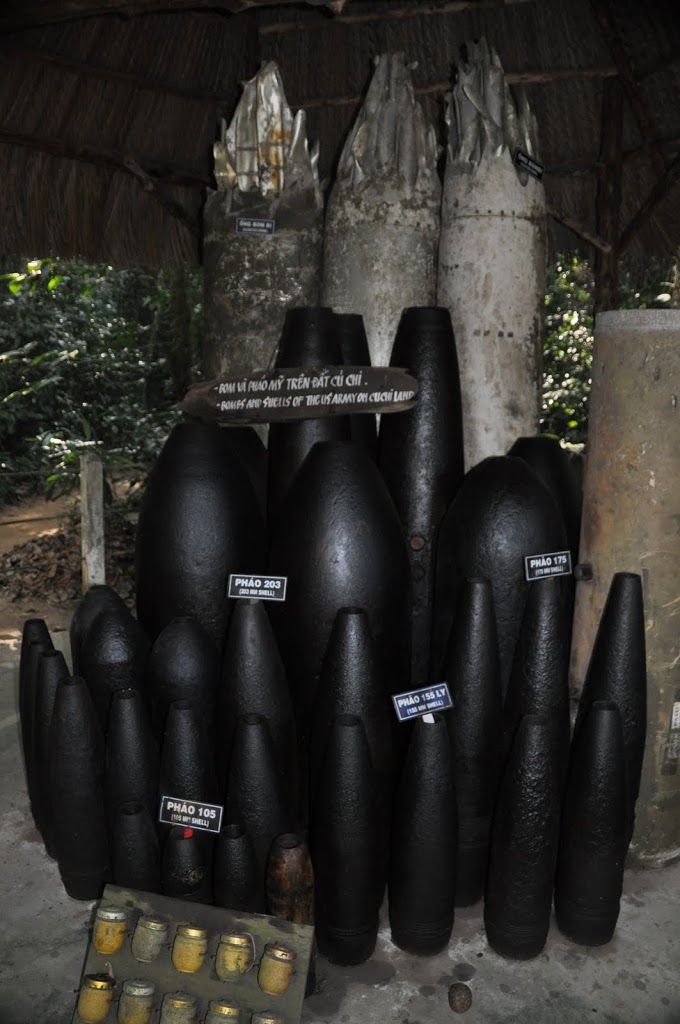
Cu Chi, an insight as to how and why America lost the War
“We’re going to bomb them into the Stone Age” – General Curtis LeMay, Chief of Staff, US Air Force, Vietnam War
You have to give them an A for effort; they certainly tried. It was not for a lack of ordinance or the number of missions flown.
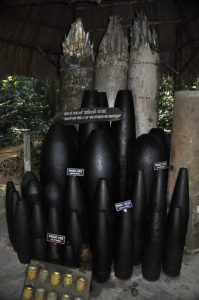
Lori and I are living in a small town called Bihn Den. I did not realize at the time we booked our volunteer mission what the strategic relevance of this area was. I was hoping to hear a story involving a piece of shrapnel or two that found its way into the village. In actuality, Bihn Den was one of the most targeted bombing areas in the entire country. If you remember seeing pictures on CBS back in the day of B-52’s carpet bombing; if you’ve seen napalm being dropped out of the sky – liquid fire designed to burn everything in its path; if you’ve seen cluster bombs drop on the ground, split open and exploding jagged metal shards in all directions; if you’ve seen Agent Orange turn forests into defoliated zones of death – well, welcome to my village.
Binh Den is 3 kilometers from one of the two main entrances to the Cu Chi tunnels. The tunnels, evaluated on any level – from a perspective of engineering, human commitment, or ingenuity are one of the most amazing sights I’ve come across in my life. Ever. Anywhere. And I’ve seen some good stuff. Built as an underground defence against the French in the 30’s and 40’s, they were dramatically expanded when the US arrived. Spreading out over 200 kilometers, they form an intricate network of tunnels and underground chambers that ultimately helped bring the US to their knees. There were three levels of tunnels, one at 10 meters underground, another layer at 20 meters and a third one at 30 meters. They were dug using hand shovels by the local farmers who were by and large either sympathetic to the Viet Cong or co-opted into the program. At night they farmed, during the day they dug. Except during of the daily ritual of hiding in the tunnels as the US bombed the living crap out of them. One of the only benefits of regular bombardment was that it provided a whole bunch of craters, great places to hide the dirt from the new tunnels.
Lori and I took the local bus down the road and had a three hour ‘history lesson’. Discounting the propaganda by 100%, the actuality of the results is unassailable. The US would soften up the area every day with an hour of intense bombings and would then follow up by sending in the infantry or the marines. The problem is – you can’t kill what you can’t see. The area was situated 5 kilometers from the US 5th division, about 7-8,000 GI’s occupied the nearby base. Little did they know that the tunnels actually went right under their base and the guerillas and VC could actually use listening devices to hear what was going on. To make matters worse, a good number of locals employed at the base by the US as cooks, gardeners, maids, etc. put on black pajamas at night and shot up their daytime employers. Talk about moonlighting; literally. The area is the southernmost end of the Ho Chi Minh Trail, the notorious supply route that stretched from the north into the south, once in a while crossing over into Cambodia. It ensured a regular flow of information, people and whatever minimal supplies were available. Ho was educated in England. While not in any authorized biography, I have it on reasonably good authority that he spent his summers in the US, particularly at Coney Island and Wildwood as a carny. He appeared to have a penchant for the Gopher Game, in which when you bopped one on the head suddenly two more popped up rarin’ to go. It was this device that Ho Chi Minh said in later life that inspired him to create the tunnels.
Many people visit from all over the world. Often the name is mispronounced and called the Gucci Tunnels, which explains why my cousin Judy, my sister Pam and my aunt Vera all have these elaborate winding tunnels built in their basements in Manchester, LA, and Montreal respectively.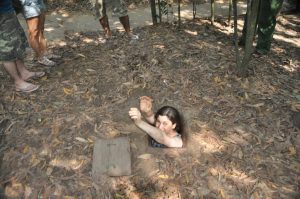
But enough of that. The tunnels are tiny; the Vietnamese aren’t so big to begin with. To work your way through, a regular sized North American or European would not physically make it. There is a 120 meter stretch that had been widened by 50% for the tourists. There were exits at 10, 20, qnd 120 meters. I was more than happy to see the light of day after 10. That people spent 8 HOURS A DAY in these claustrophobic, oxygen starved, dark, musty tunnels is a testament to the indomitable spirit of the Vietnamese. Did I mention that while in these tunnels they were being bombed, flooded, gassed and napalmed? The horrors are gut-wrenching. Our tour took us through the area in which countless incursions by the US forces took place. We were shown samples of things the Viet Cong and the locals guerrillas did to try to discourage and dissuade uninvited guests. Have you ever heard of punji sticks? 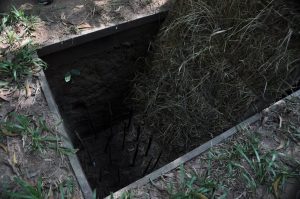
They were originally designed to hunt tigers. A 5 meter deep pit measuring 2 by 3 meters in width and length is dug. 2 meter long bamboo stalks are sharpened and placed pointy side up coming out of the ground. A woven mat covered with a thin layer of leaves and dirt is placed over the opening. The unsuspecting tiger walks on the wrong path and voila – tiger meat. In this case, the only tigers that were being hunted in the 60’s were from Clemson and Detroit. To further enhance the punji stick’s effect, the tips were covered in excrement. In case the poor guy somehow survived the piercing, the infections he received would probably kill him anyway. Add a whole bunch of other booby traps featuring barbed hooks, rolling spikes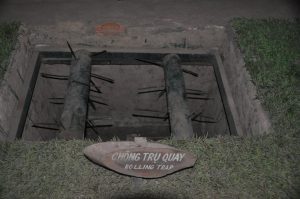
and assorted landmines (built with the TNT taken from the unexploded US bombs that were sawed in half – slowly and carefully) and you had a real recipe for hell on earth. Add malaria, 20 meter cobras, heat, and constant taunting from an invisible enemy any it makes for a sad story.
The entire tour was a major propaganda show, not all that different from a trip to Disneyland – differing values being driven home, but as McLuhan said “the media is the message”. Content is transitory. They had a disabled US tank on display that had driven over a land mine, lost its treads and its 4 occupants became sitting Peking ducks for the Viet Cong and local supporters.
Next stop on the tour was a firing range. All the while that the tour is going through the grounds, the air is constantly being punctuated with the unmistakable sound of live ammo. We arrived at the range and for about 26,000 Vietnamese Dohng ($1.40) per bullet, you could fire off M-16’s (guaranteed not to jam, unlike the models that the US were stuck with back in the war) or AK-47’s. I could not resist and bought 10 rounds. My available local currency was a bit on the low side so I asked if I could pay with US $. Not a problem I was advised (they most likely take Visa and Mastercard too), I chose the Kalashnikov. As I headed to the shooting area, the recent transaction’s irony was not lost on me. I was ponying up US dollars to fire a Russian rifle that was used by Charlie against the Americans in Vietnam. All at a huge profit to the Vietnamese Socialist Government that was racking up a profit that was to such excess that it would have made Warren Buffet blush. By the way, if you plan to come after my house and family, anything inside 150 meters is instant dead meat. My aim is apparently very much like Elvis Costello’s. Gotta pick up an AK-47 somewhere. Lori says that there was a rather intense look on my face as I shot. 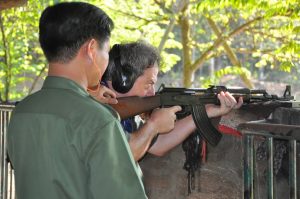
Something about gunpowder and guns. Can’t explain it but it gets you down low.
The tour ended with a 15 minute ‘Documentary’ filmed in 1967 by the South Vietnam Resistance Movement. The grainy black and white film, showing the idyllic life in the sleepy riverside village of Cu Chi, put to ruin by the invaders, necessitating an ardent struggle that pitted schoolgirls, farmers, and factory workers who had never held a gun against the strongest fighting force in the world.
Only Michael Moore’s films display less credibility, but the bottom line – they won. Interestingly, during the film, reference was made to the American soldiers, including specially named medals for killing them, but at no point was there any hint or suggestion that there was any compliance or involvement by any Vietnamese. South Vietnam had the ARVN, a full fighting force dedicated to combating the North Vietnamese. To see this film, one was certain that the running dog round eyes were acting on their own against the Vietnamese.
We live in the village, the war is not mentioned and there are no physical signs remaining on the landscape. As we sat on the bus, a 50-something woman alit at the subsequent stop. She was using a crutch since she did not have the bottom half of her left leg. It was supported by a stump of what had been a left arm. I could not help but think that while the countryside has recovered, the bodies, minds, and souls of both sides of those who endured the unleashed hellfire of the Vietnam War never have nor ever will.


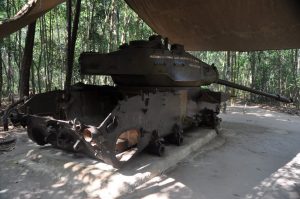
Ron
Posted at 18:24h, 29 DecemberDear Bruce and Lori interesting beginning well done love Ron